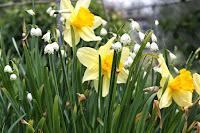What to Plant Under Trees
One of the most commonly asked questions about
gardening is what to do about the areas under trees.
It seems like those shady,
dry places around trees bother gardeners who would like to have their gardens pretty
to look at from every angle.
Not only is the soil dry under trees since trees
quickly drink surface water, the roots are dense and do not allow room for digging.
On top of all that, digging around tree roots can damage the health of the tree
in the long term.
Sometimes we see flower beds planted around trees
and that solution can work quite well as long as it is a bed full of perennials
and the plants are in the ground rather than in a raised bed. Raised beds
planted on top of tree roots can smother the tree’s roots, stunting the growth
and shortening the life of the tree.
The first rule for healthy plants under trees is to
completely avoid annual plants such as begonias and petunias that absorb water
and nutrients needed by the tree. Each spring or fall when annuals are planted
your trees’ roots are being torn and cut. Also, annual plants have shallow
roots and require more frequent irrigation than is healthy for the top roots of
trees.
The ideal solution is to plant long-living
groundcovers and other perennials around the drip line of young trees at
planting time. Over the years, the young tree’s roots will fill in around the
ornamental plants’ roots and they will find a healthy growing situation
together.
And, planting under trees it is best to purchase
small perennials rather than gallon- sized containers.
The smaller root ball in a 4-inch plant will
require a smaller hole and do less damage to the tree roots. Yes, it will take
an extra year to fill in the space but a light mulch cover will keep the area
looking good, help the soil retain moisture, and give both plants a better
chance.
There are dozens of perennial plants that thrive
under trees. Look for native perennials that want dappled, part-shade or
full-shade. Native perennial selections are better adapted to your local soil
types, rainfall, heat and humidity patterns.
As a rule of thumb, avoid plants that are Japanese,
Chinese, Korean and Asian in origin. Most of these plants spread fast in our
soil and weather, quickly becoming a problem that has to be managed under
trees.
Examples of popular plants in this potential-problem
category include: Bamboo, Chinese Wisteria, Japanese Callicarpa (beautyberry),
Japanese privet, Asian jasmine, Japanese honeysuckle, etc. English ivy also
quickly becomes a problem plant, choking tree roots and trunks.
Fall planted, spring flowering bulbs are compatible
with tree roots. Select the tiny daffodils, hyacinths, crocus and snowdrops
that do not need to planted deep and prefer the summer dry soil.
Rhododendrons and their cousins Azaleas also enjoy
dappled light but their roots need to be kept moist, so their root balls should
be planted farther out by the tree’s drip line which is located at the end of
the trees’ branches. Hostas and cold-hardy begonias are other great selections
for that area.
Native, perennial, woodland, wildflowers thrive
under trees and live compatibly close to the trunks.
Those possibilities
include: Toothwort (Cardamine
concatenata), Bloodroot (Sanguinaria candensis), Wild Ginger/Snakeroot
(Asarum canadense), Virginia bluebells (Mertensia
virginica), white trout lily (Erythronium
albidium), May apple (Podophyllum
peltatum) and sharp-lobed hepatica (Hepatica acutiloba), Phlox divaricata (native or wild blue phlox),
American Alum Root (Heuchera Americana) Jacob’s Ladder (Polemonium reptans), Allegheny
Spurge (Pachysandra procumbens), etc.
Sources: Area Farmers’ Markets, plant shows, Grogg’s
Green Barn in Tulsa (groggsgreenbarn.com)
Mail-order: Prairie Nursery www.prairienursery.com,
Pine Ridge Gardens www.pineridgegardens.com,
Missouri Wildflowers www.mowildflowers.net




Comments